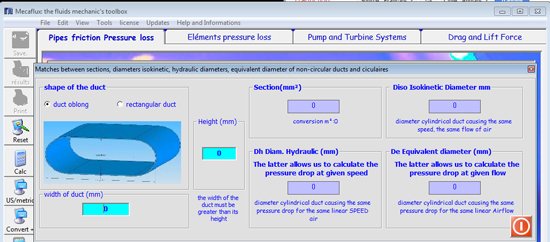
The dimensions of pipes or tubes of a hydraulic system or ventilation are generally calculated according to the desired flowrate. The diameters of the ducts are usually the input parameter. For non-circular ducts, the oblong or rectangular section,we need to use the concepts of equivalent diameters, diameters iso kinetic or hydraulic diameters.This allows to calculate the pressure drops, flow, or fluid speed in rectangular ducts, as if they were circular.
The pipe section may be circular, rectangular or oblong,
A conversion window for equivalent diameter is integrated into software mecaflux with, iso kinetic diameters and hydraulic diameter
Conversion equivalent hydraulic diameters and the isokinetic mecaflux software.
To calculate the pressure loss of a linear conduit of rectangular or oblong cross section:
- When the specification imposes on us the speed: DH is used (hydraulic diameter). Ex:A fluid flows 2 m/sec in a rectangular duct 200 x 100, the pressure drop is calculated as for a pipe diameter 133 by selecting in the tab major head loss, "I prefer to enter the speed", and entering speed 2 m/sec .
- De is used (equivalent diameter). Ex:A fluid flows at 2 m3h in a rectangular duct 200 x 100, the pressure drop is calculated as for a pipe diameter 152 selecting and entering the flow 2 m3h in the major loss tab.
The isokinetic diameter is informative, When the pipe is evaluated , Ex: we know that our conduct must convey the same flow at the same speed as in a pipe of 160 mm diameter, dimensions 200 x 100 will be applied to keep this operating.
